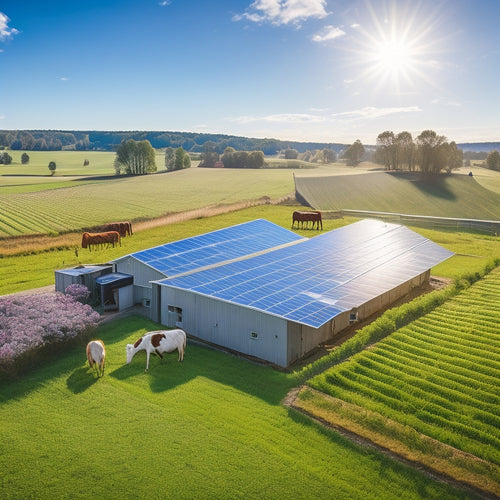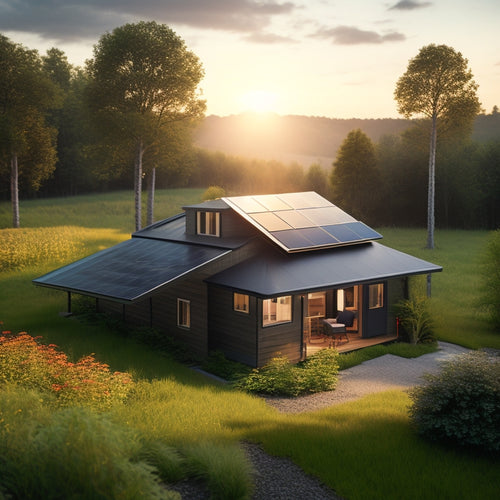
Diy Home Solar Power System
Share
By investing in a DIY home solar power system, you can greatly reduce your reliance on the grid, lower your electricity bills, and increase your property value, all while contributing to a sustainable future and taking advantage of government incentives and utility rebates. You'll be able to optimize your energy consumption, reduce waste, and maximize energy generation with the right technologies, like maximum power point tracking and energy-efficient appliances. As you assess your energy usage and implement smart power management strategies, you'll reveal the full potential of your DIY solar system and move closer to energy independence.
The Essentials
- Installing a DIY home solar power system reduces reliance on the grid and leads to decreased energy expenses.
- Government incentives and utility rebates can help offset high upfront installation costs.
- Conducting energy audits and optimizing energy consumption can reduce waste and enhance electricity generation.
- Solar power systems can increase property value by up to 17% and attract eco-conscious buyers.
- Maximizing energy harvesting through optimal solar panel orientation and energy storage solutions ensures full utilization of solar panel potential.
Save Money on Electricity
You can greatly lower your electricity bill by utilizing free energy from the sun.
By installing a DIY home solar power system, you'll reduce your reliance on the grid and decrease your energy expenses.
With a well-designed home solar kit, you can address common issues like high upfront costs and limited energy storage capabilities.
Additionally, you'll also reduce energy waste by optimizing your energy consumption and making the most of the electricity you generate.
Lower Your Bill
With electricity costs rising steadily, a DIY home solar power system can be a savvy investment for homeowners seeking to slash their energy expenses. You can greatly lower your electricity bill by utilizing the power of the sun.
By installing a solar power system, you'll generate free energy during the day, reducing your reliance on the grid and subsequently, your electricity costs. In addition, embracing a cleaner, more sustainable future with Renewable Energy Solutions can also provide backup power during outages and emergencies, offering peace of mind and safeguarding against lost productivity and spoiled food.
Additionally, you can take advantage of solar incentives and utility rebates offered by the government and utility companies. These incentives can help offset the initial cost of installation, making it more feasible to switch to solar power.
For instance, the Solar Investment Tax Credit (ITC) allows you to claim a tax credit of up to 26% of the total cost of your solar power system. Additionally, many utility companies offer rebates for homeowners who install solar panels, further reducing the cost of switching to renewable energy.
Reduce Energy Waste
How much of your hard-earned money is being wasted on unnecessary energy consumption? You can't afford to ignore energy waste, especially when you're investing in a DIY home solar power system.
Conducting energy audits helps identify areas of inefficiency, and addressing them can lead to significant savings. Insulation upgrades, for instance, can reduce heat loss and gain, while smart thermostats optimize your heating and cooling systems.
Replacing traditional appliances with energy-efficient ones and making lighting improvements also contribute to energy conservation. Effective power management is vital, as it guarantees you're using the energy you generate wisely.
By utilizing renewable resources and adopting energy-conscious habits, you'll reduce your reliance on the grid and lower your electricity bills. Don't forget to take into account building orientation and energy monitoring to maximize your system's performance.
A well-designed off-grid energy system can provide the independence you need, and with deep cycle batteries, you can store excess energy for later use.
Increases Property Value Fast
You'll increase your property's value quickly with a DIY home solar power system, which can enhance your selling price and raise your home's appeal.
By utilizing renewable energy, you'll not only reduce your carbon footprint but also make your property more attractive to potential buyers.
In fact, studies have shown that solar-powered homes sell for more than their non-solar counterparts.
Boosts Selling Price
Installing a DIY home solar power system can greatly enhance your property's selling price, making it a highly attractive feature to potential buyers in today's eco-conscious market. As a homeowner, you'll reap the benefits of energy independence and sustainable living, which are highly valued by modern homebuyers.
| Benefits | Description |
|---|---|
| Increased Property Value | A solar power system can increase your property's value by up to 17% |
| Energy Efficiency | Reduce your reliance on the grid and enjoy lower energy bills |
| Environmental Appeal | Attract eco-conscious buyers who prioritize sustainable living |
| Government Incentives | Take advantage of tax credits and rebates for solar installations |
| Competitive Advantage | Stand out from other listings with a modern, eco-friendly feature |
Raises Home Appeal
Aesthetic appeal is a significant factor in a property's resale value, and a DIY home solar power system can drastically enhance your home's curb appeal, making it a coveted gem in the eyes of potential buyers.
By incorporating eco-friendly features, you're not only reducing your environmental impact but also elevating your property's value. A well-designed solar panel system can become a stunning outdoor aesthetic upgrade, showcasing your commitment to sustainable living.
Modern design and green technology seamlessly blend together in a DIY solar power system, giving your home a sleek, contemporary look. As you achieve energy independence, you'll also augment your home's appeal to environmentally conscious buyers.
A DIY solar power system is a smart home renovation move, as it can recoup up to 100% of its cost at resale. By investing in a DIY solar power system, you're not only reducing your energy bills but also increasing your property's value, making it an attractive investment for you and potential buyers alike.
Maximum Power Point Tracking
You'll want to guarantee your DIY home solar power system incorporates maximum power point tracking (MPPT) to enhance solar panel efficiency and optimize energy harvesting.
By pairing MPPT with a reliable off-grid systems, you can guarantee a steady flow of energy even during power outages.
MPPT technology continuously monitors and adjusts the system's operating voltage to match the maximum power point of your solar panels, resulting in up to 30% more energy production.
Solar Panel Efficiency Boost
Maximum power point tracking (MPPT) is the process by which a solar panel's output is optimized to guarantee it produces the maximum possible power. You can think of it as the solar panel's "turbocharger".
By constantly monitoring the panel's voltage and current, the MPPT system adjusts the electrical load to guarantee the panel operates at its peak performance. This results in up to 30% more energy harvested from your solar technology investment.
In a DIY home solar power system, MPPT is essential for maximizing energy storage. By optimizing energy production, you'll be able to store more power in your batteries, reducing your reliance on the grid and increasing your energy independence.
With MPPT, you'll be able to utilize the full potential of your solar panels, even on cloudy or partially shaded days. By taking control of your energy production, you'll be able to enjoy the freedom that comes with generating your own clean, renewable energy.
Optimizing Energy Harvesting
To get the most out of your solar panels, it's important to enhance energy harvesting through maximum power point tracking (MPPT).
You'll want to maximize your energy output by making sure your solar panel orientation is ideal for your location and adjusting it seasonally to capture the most sunlight. Investing in energy storage solutions will also help you store excess energy for later use, reducing your reliance on the grid and increasing your grid independence.
When installing your DIY solar power system, follow installation tips to guarantee your panels are properly angled and secured.
Consider the environmental impact of your system and choose components with minimal waste and recyclable materials. Regular maintenance is vital to make certain your system operates at peak efficiency, so be prepared to perform routine checks and cleaning.
Research local incentives and take advantage of rebates or tax credits to offset the cost of your system. Proper system sizing is also significant to verify you're generating enough power to meet your energy needs.
Assess Your Energy Usage
You need to determine your daily energy consumption to size your solar power system correctly.
To do this, you'll want to track your energy usage patterns, including the times of day you use the most power and the appliances that consume the most energy.
To maximize energy savings, it's crucial to contemplate implementing a home energy management system home energy management systems that can help you monitor and control your energy usage.
Daily Energy Consumption
Determining your daily energy consumption is an essential step in designing an effective DIY home solar power system. You need to know how much energy you use daily to determine the size of the solar power system you require. Conducting an energy audit will help you identify consumption trends and pinpoint areas where you can reduce energy usage.
To get an accurate representation of your daily energy consumption, you should track your energy usage over a period of time. You can do this by monitoring your utility bills or using a smart plug to track the energy usage of individual appliances.
| Appliance | Average Daily Energy Consumption (kWh) |
|---|---|
| Refrigerator | 1.5 - 2.5 kWh |
| Air Conditioner | 3 - 5 kWh |
| LED Lights | 0.5 - 1 kWh |
| Laptop | 0.2 - 0.5 kWh |
Energy Usage Patterns
Understanding your energy usage patterns is essential in designing an effective DIY home solar power system, as it helps identify periods of high energy demand and opportunities for reduction. By conducting an energy audit, you'll uncover consumption trends that highlight peak usage periods, seasonal variations, and areas for improvement.
This analysis will enable you to optimize appliance efficiency, implement smart power management strategies, and make lifestyle adjustments that reduce your energy footprint.
As you assess your energy usage, consider the impact of renewable sources on your overall consumption. By integrating solar power into your system, you'll reduce your reliance on the grid and enjoy future savings on your energy bills.
Additionally, you'll be taking a significant step towards grid independence, freeing yourself from the constraints of traditional energy providers. By understanding your energy usage patterns, you'll be equipped to make informed decisions about your energy needs, ultimately achieving the freedom and autonomy you desire.
Higher Energy Conversion Rate
You can greatly enhance your solar power system's performance by focusing on maximizing energy output.
This involves selecting high-efficiency solar panels, optimizing panel orientation and tilt, and ensuring minimal energy losses throughout the system.
Maximized Energy Output
Since the efficiency of your DIY home solar power system directly impacts your energy independence and cost savings, maximizing energy output is crucial.
To achieve this, you'll need to optimize your solar panel orientation. Ideally, your panels should face south (in the northern hemisphere) and be tilted at an angle equal to your latitude. This guarantees maximum exposure to direct sunlight throughout the day.
You'll also need to take into account energy storage solutions to maximize energy output. A deep-cycle battery bank with a high capacity will allow you to store excess energy generated during the day for use during the night or on cloudy days.
A charge controller and inverter will help regulate the flow of energy between your solar panels, battery bank, and home. By optimizing your solar panel orientation and energy storage solutions, you'll be able to maximize your energy output, reducing your reliance on the grid and increasing your energy independence.
Frequently Asked Questions
Are DIY Solar Power Systems Safe to Install Myself?
When installing solar panels yourself, you'll need to guarantee installation safety by following wiring guidelines, adhering to local building codes, and taking necessary precautions to avoid electrical shock or fire hazards.
Can I Use a DIY Solar System With a Septic Tank?
You'll be pleased to know that your septic system won't interfere with a DIY solar system, as they operate independently. In fact, you can optimize solar energy efficiency by placing panels in areas with minimal shading, ensuring a reliable, off-grid power source for your septic system.
Do Solar Panels Work Well in Shaded Areas?
As you venture into the domain of solar energy, you'll find that shading effects can greatly impact solar panel efficiency, reducing it by up to 20%.
Can I Add More Panels to My System Later?
You can expand your system by adding more panels later, but you'll need to take into account the installation costs and potential panel expansion limitations set by your initial system's design and local building codes.
Are DIY Solar Power Systems Compatible With Grid-Tie Systems?
You're wondering if DIY solar systems are compatible with grid-tie systems; the answer is yes, they can be, but it's essential to verify grid tie compatibility and follow specific DIY installation tips to avoid system conflicts and optimize energy production.
Final Thoughts
You'll be amazed at the astronomical savings you'll reap with a DIY home solar power system! Your electricity bills will plummet, and your property value will skyrocket in no time. With maximum power point tracking, you'll utilize every last watt of energy. By evaluating your energy usage, you'll optimize your system for maximum efficiency. And with a higher energy conversion rate, you'll be generating power like a pro! Get ready to bask in the glory of energy independence and watch your savings soar!
Related Posts
-

What Do I Need to Know About Farm Solar Panels
When considering farm solar panels, you need to assess costs, benefits, and technical specifics. Initial investment c...
-

Top Portable Refrigerators for Camping Adventures
When you're camping, having a reliable portable refrigerator can make all the difference for keeping your food fresh ...
-

Diy Off Grid Solar
By embracing DIY off-grid solar, you can break free from grid dependence, slashing your energy bills by up to 90% and...


